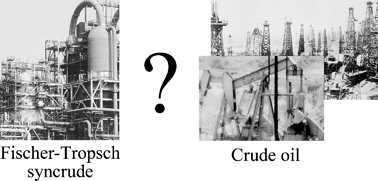Projected changes in crude oil refinery design to meet future fuel specifications require that intermediates are produced that are already present in Fischer–Tropsch syncrude. A qualitative comparison is made between syncrude and crude oil, and the refinery designs needed to convert these raw materials into transportation fuels. Syncrude is sulfur free, nitrogen free and contains no heteroatom rich residues, making its purification and separation less complex than that of crude oil. The conversion units needed to produce motor-gasoline, jet fuel and diesel from syncrude are of similar complexity to that of crude oil, but crude oil residue conversion is much more involved. Furthermore, cleaner conversion technologies can be used to upgrade syncrude. A Fischer–Tropsch refinery consequently has a smaller environmental footprint than a crude oil refinery.
You have access to this article
 Please wait while we load your content...
Something went wrong. Try again?
Please wait while we load your content...
Something went wrong. Try again?


 Please wait while we load your content...
Please wait while we load your content...